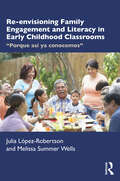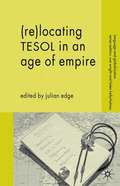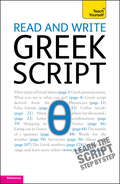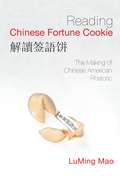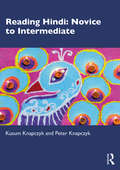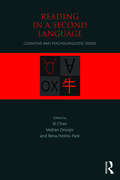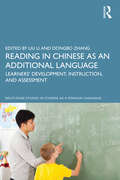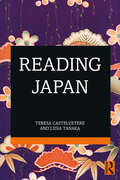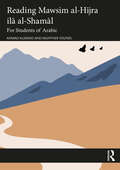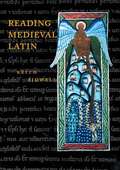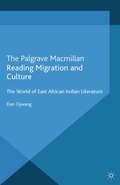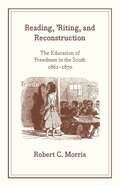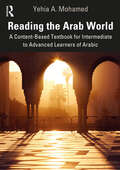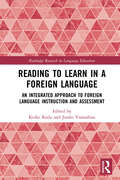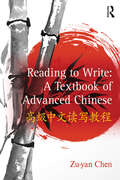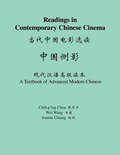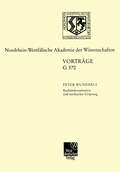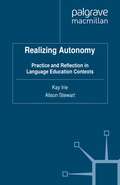- Table View
- List View
Re-envisioning Family Engagement and Literacy in Early Childhood Classrooms: "Porque así ya conocemos"
by Julia López-Robertson Melissa Summer WellsFamilies are resources that are extremely powerful and important for young learners from minoritized backgrounds, yet such families are often overlooked, silenced, or ostracized. This book presents a much-needed framework for family and community engagement in the early childhood and elementary literacy classroom that embraces and foregrounds students’ unique cultural backgrounds. This book spotlights the families of minoritized learners and the crucial role that they play in building dynamic and inspiring environments for learning. To re-envision the engagement of these families in the early childhood classroom, the book provides an accessible understanding of Yosso’s theory of community cultural wealth. Covering key topics such as children’s literature and digital tools, the book features strategies for implementing culturally responsive classroom practices to create positive home–school partnerships. Each chapter highlights one type of capital in community cultural wealth—aspirational, linguistic, familial, social, navigational, and resistant—and gives teachers guidance on working with and supporting the efforts of families both inside and outside of the classroom. This book is an essential resource to inform current and future early childhood educators on how to gain deeper understandings of what families—especially from Communities of Color—already are doing for the education of their children, and how best to support them.
(re-)locating Tesol In An Age Of Empire (PDF)
by Julian EdgeAre TESOL professionals now fairly seen as agents of a new English-speaking empire? Or, if they wish to distance themselves from this role, are there ways of working and living that would make this differentiation clear? An international group of authors put forward their differing proposals for the development of TESOL.
Read and write Greek script: Teach Yourself (Read and Write Languages)
by Sheila Hunt Dennis CouniacisMaster Greek script with this straightforward guide from Teach Yourself - the No. 1 brand in language learning. Read and write Greek script is a clear step-by-step guide to the written language, with plenty of examples from real-life texts to show how it works in context and lots of exercises to reinforce your learning. This new edition has an easy-to-read page design.Now fully updated to make your language learning experience fun and interactive. You can still rely on the benefits of a top language teacher and our years of teaching experience, but now with added learning features within the course and online. Learn effortlessly with new, easy-to-read page design and interactive features: NOT GOT MUCH TIME?One, five and ten-minute introductions to key principles to get you started.AUTHOR INSIGHTSLots of instant help with common problems and quick tips for success, based on the author's many years of experience.USEFUL VOCABULARYEasy to find and learn, to build a solid foundation for speaking.TEST YOURSELFTests in the book and online to keep track of your progress.EXTEND YOUR KNOWLEDGEExtra online articles at: www.teachyourself.com to give you a richer understanding of the culture and history of Greece.TRY THISInnovative exercises illustrate what you've learnt and how to use it.
Reading Chinese Fortune Cookie: The Making of Chinese American Rhetoric
by LuMing MaoLuMing Mao offers an important discussion of the rhetoric of Chinese American speakers, which has wide implications for the teaching of writing in English and for our understanding of cross-cultural influences in discourse. Recent scholarship tends to explain such influences as contributing to language hybridity---an advance over the traditional "deficit model." But Mao suggests that the "hybridity" approach is perhaps too arid or sanitized, missing rich nuances of mutual exchange, resistance, or even subversion. Working from Ang's concept of "togetherness in difference," Mao suggests that speakers of hybrid discourse may not be attempting the standard (and failing), but instead may be deliberately importing cultural material to create a distance between themselves and the standard. This practice, over time, becomes a process that transforms English, enriching and enlarging it through the infusion of non-Western discourse features, subverting power structures, and even providing unique humorous touches. Of interest to scholars in composition, cultural studies, and linguistics as well, Reading Chinese Fortune Cookie leads in an important new direction for both our understanding and our teaching of English.
Reading Hindi: Novice to Intermediate
by Kusum Knapczyk Peter KnapczykReading Hindi: Novice to Intermediate is an innovative collection of graded readings that are both accessible in language and engaging in content, specifically designed for adult learners of Hindi. Ideal for those just starting out in Hindi, the texts provide culturally rich content written in simple, level-appropriate language, with a range of activities to reinforce learning. The graded readings support the learner as they build their confidence with the language, gradually encountering a wider range of grammar constructions and vocabulary as the book progresses. Reading Hindi can be used alongside a main textbook and is ideal for both class-use and independent study.
Reading in a Second Language: Cognitive and Psycholinguistic Issues
by Xi Chen Rena Helms-Park Vedran DronjicReading in a Second Language offers a comprehensive survey of the phenomenon and process of reading in a second language, with graduate and upper-level undergraduate students in second language acquisition, psycholinguistics, and applied psychology as its primary audience. The book explores reading processes from a number of complementary standpoints, integrating perspectives from fields such as first and second language reading, second language acquisition, linguistics, psycholinguistics, and cognitive neuroscience. The first half examines major factors in second language reading: types of scripts, the cognitive and neural substrates of reading; metalinguistic awareness, word recognition, language transfer, and lexical knowledge. The second part of the book discusses the social and educational contexts in which reading development occurs, including issues related to pedagogy, the use of technology in the classroom, reading disorders, and policy making. Reading in a Second Language provides students with a full, logically organized overview of the primary factors that shape reading development and processes in a second language.
Reading in a Second Language: Cognitive and Psycholinguistic Issues
by Xi Chen Rena Helms-Park Vedran DronjicReading in a Second Language offers a comprehensive survey of the phenomenon and process of reading in a second language, with graduate and upper-level undergraduate students in second language acquisition, psycholinguistics, and applied psychology as its primary audience. The book explores reading processes from a number of complementary standpoints, integrating perspectives from fields such as first and second language reading, second language acquisition, linguistics, psycholinguistics, and cognitive neuroscience. The first half examines major factors in second language reading: types of scripts, the cognitive and neural substrates of reading; metalinguistic awareness, word recognition, language transfer, and lexical knowledge. The second part of the book discusses the social and educational contexts in which reading development occurs, including issues related to pedagogy, the use of technology in the classroom, reading disorders, and policy making. Reading in a Second Language provides students with a full, logically organized overview of the primary factors that shape reading development and processes in a second language.
Reading in Chinese as an Additional Language: Learners’ Development, Instruction, and Assessment (Routledge Studies in Chinese as a Foreign Language)
by Liu Li Dongbo ZhangReading in Chinese as an Additional Language focuses on Chinese literacy acquisition, which has been considered most difficult by both learners and teachers of Chinese as an additional language (CAL). Three major areas are covered: (1) acquisition of Chinese characters; (2) reading comprehension subskills and reader’s identity; (3) reading instruction and assessment. The first part delves into the foundation of Chinese literacy development—how to learn and teach Chinese characters. The second part examines various learners’ reading comprehension subskills, as well as the evolution of learners’ literacy identity. The third part explores effective instructional methods and assessment practices for CAL reading development. Theoretically, this book provides frameworks and evidence from both cognitive and sociocultural perspectives on the nature of CAL reading development. Pedagogically, the book showcases how to teach and assess CAL reading skills. Methodologically, this book includes empirical studies using both qualitative and quantitative methods. In terms of scope, the book covers a much broader spectrum of issues about CAL reading research and classroom teaching than has previously been available. Writing is also discussed in several chapters. In terms of technology, the book includes discussion on how the use of computers, the Internet, and social media impacts students’ Chinese literacy acquisition. This book will help CAL researchers and educators better understand the nature of CAL reading development and become well informed about CAL classroom teaching and assessment, including the application of interactive approaches to teaching and assessing diverse reading skills.
Reading in Chinese as an Additional Language: Learners’ Development, Instruction, and Assessment (Routledge Studies in Chinese as a Foreign Language)
by Liu Li Dongbo ZhangReading in Chinese as an Additional Language focuses on Chinese literacy acquisition, which has been considered most difficult by both learners and teachers of Chinese as an additional language (CAL). Three major areas are covered: (1) acquisition of Chinese characters; (2) reading comprehension subskills and reader’s identity; (3) reading instruction and assessment. The first part delves into the foundation of Chinese literacy development—how to learn and teach Chinese characters. The second part examines various learners’ reading comprehension subskills, as well as the evolution of learners’ literacy identity. The third part explores effective instructional methods and assessment practices for CAL reading development. Theoretically, this book provides frameworks and evidence from both cognitive and sociocultural perspectives on the nature of CAL reading development. Pedagogically, the book showcases how to teach and assess CAL reading skills. Methodologically, this book includes empirical studies using both qualitative and quantitative methods. In terms of scope, the book covers a much broader spectrum of issues about CAL reading research and classroom teaching than has previously been available. Writing is also discussed in several chapters. In terms of technology, the book includes discussion on how the use of computers, the Internet, and social media impacts students’ Chinese literacy acquisition. This book will help CAL researchers and educators better understand the nature of CAL reading development and become well informed about CAL classroom teaching and assessment, including the application of interactive approaches to teaching and assessing diverse reading skills.
Reading Japan
by Teresa Castelvetere Lidia TanakaReading Japan offers the student readings on geopolitics, education, language, Japanese-ness and ethnicity, gender and history, with the dual aims of broadening students’ understanding of Japan and of providing opportunities to read authentic Japanese texts. Each chapter contains an essay in English, a selection of readings in Japanese, comprehensive vocabulary lists, discussion questions and a list of sources and additional readings. Pitched at Intermediate to Advanced and B1-C1 level, this reader is not simply a language textbook; it offers students a chance to learn and think in depth about Japan as they build confidence in reading real-world Japanese texts.
Reading Mawsim al-Hijra ilā al-Shamāl: For Students of Arabic
by Ahmad Alswaid Munther YounesReading Mawsim al-Hijra ilā al-Shamāl: For Students of Arabic is intended for advanced students of Arabic who have studied the language for at least two years at college level or the equivalent. The book is based on Tayeb Salih’s novel Mawsim al-Hijra ilā al-Shamāl, a masterpiece in modern Arabic literature. This book is designed to accompany the novel, which the authors divided into 60 parts, each of which consists of 400–500 words of the original text. A lesson is built on each part and starts with a reference to the first and last sentences in it. This is followed by a list of new vocabulary and a variety of activities and exercises, some oral and some written, whose goal is to develop students’ listening, speaking, reading, and writing skills and knowledge of Arabic language, culture, and literature. The book ends with a glossary of literary terms. The book’s e-resources include a comprehensive glossary of words arranged by root, a glossary of expressions, and other resources. The book can be used as a main or a supplementary text in an Arabic language course or for independent study.
Reading Mawsim al-Hijra ilā al-Shamāl: For Students of Arabic
by Ahmad Alswaid Munther YounesReading Mawsim al-Hijra ilā al-Shamāl: For Students of Arabic is intended for advanced students of Arabic who have studied the language for at least two years at college level or the equivalent. The book is based on Tayeb Salih’s novel Mawsim al-Hijra ilā al-Shamāl, a masterpiece in modern Arabic literature. This book is designed to accompany the novel, which the authors divided into 60 parts, each of which consists of 400–500 words of the original text. A lesson is built on each part and starts with a reference to the first and last sentences in it. This is followed by a list of new vocabulary and a variety of activities and exercises, some oral and some written, whose goal is to develop students’ listening, speaking, reading, and writing skills and knowledge of Arabic language, culture, and literature. The book ends with a glossary of literary terms. The book’s e-resources include a comprehensive glossary of words arranged by root, a glossary of expressions, and other resources. The book can be used as a main or a supplementary text in an Arabic language course or for independent study.
Reading Medieval Latin
by Keith C. SidwellReading Medieval Latin is an anthology of Medieval Latin texts, arranged chronologically and thematically with introductions, commentaries and a vocabulary of nonclassical words and meanings. It is a language textbook, designed to introduce students with one year or more of Latin to the Latin writing and culture of the period A. D. 550-1200. It is the only systematic introduction for students to all types of Medieval Latin writing.
Reading Migration and Culture: The World of East African Indian Literature
by Dan OjwangThis book uses the uniquely positioned culture of East African Asians to reflect upon the most vexing issues in postcolonial literary studies today. By examining the local histories and discourses that underpin East African Asian literature, it opens up and reflects upon issues of alienation, modernity, migration, diaspora, memory and nationalism.
Reading Petronius
by Niall W. Slater[Amazon] Review "Slater has written a highly readable book about Petronius' tantalizing work, using modern critical methods ably to inform his presentation... This book offers much for students of Petronius and of skillfully applied criticism." -- Classical World
Reading, 'Riting, and Reconstruction: The Education of Freedmen in the South, 1861-1870
by Robert C. MorrisThis study of education for freedmen following Emancipation is the definitive treatment of the subject. Employing a wide range of sources, Robert C. Morris examines the organizations that staffed and managed black schools in the South, with particular attention paid to the activities of the Freedman’s Bureau. He looks as well at those who came to teach, a diverse group—white, black, Northern, Southern—and at the curricula and textbooks they used. While giving special emphasis to the Freedmen’s Bureau school program, Morris places the freedmen’s educational movement fully in its nineteenth-century context, relating it both to the antislavery crusade that preceded it and to the conservative era of race relations that followed.
Reading the Arab World: A Content-Based Textbook for Intermediate to Advanced Learners of Arabic
by Yehia A. MohamedReading the Arab World is a content-based textbook for intermediate to advanced students of Arabic, designed to enhance language skills through exposure to authentic texts. Students will develop their reading, writing, speaking, and critical thinking skills as they learn about the most contemporary issues shaping the Arab world through a range of authentic texts. The choice of texts and authors is diverse and includes texts from various sources and geographical regions in the Arab world, as well as authors of different genders, ages, generations, and schools of thought, thus ensuring a compelling range of viewpoints and angles. Each text is supported by relevant tasks such as vocabulary exercises, comprehension activities, and discussion questions. This is an ideal resource for students of Arabic as a second or heritage language, working at or above the Intermediate-High level on the ACTFL proficiency scale.
Reading the Arab World: A Content-Based Textbook for Intermediate to Advanced Learners of Arabic
by Yehia A. MohamedReading the Arab World is a content-based textbook for intermediate to advanced students of Arabic, designed to enhance language skills through exposure to authentic texts. Students will develop their reading, writing, speaking, and critical thinking skills as they learn about the most contemporary issues shaping the Arab world through a range of authentic texts. The choice of texts and authors is diverse and includes texts from various sources and geographical regions in the Arab world, as well as authors of different genders, ages, generations, and schools of thought, thus ensuring a compelling range of viewpoints and angles. Each text is supported by relevant tasks such as vocabulary exercises, comprehension activities, and discussion questions. This is an ideal resource for students of Arabic as a second or heritage language, working at or above the Intermediate-High level on the ACTFL proficiency scale.
Reading to Learn in a Foreign Language: An Integrated Approach to Foreign Language Instruction and Assessment (Routledge Research in Language Education)
by Keiko Koda Junko YamashitaThis book describes a theory-guided approach to Foreign Language (FL) course development, implementation, instruction and assessment. It documents the development and implementation of a theory-guided approach designed to exploit cross-linguistically sharable competencies as resources for promoting FL learning. The volume delineates the processes of (a) identifying cross-linguistically sharable competencies, (b) exploring ways of exploiting sharable competencies as resources in promoting language skills through their purposeful use for content learning, (c) implementing the instructional approach in multiple EFL classrooms, and (d) evaluating the approach by comparing learning outcomes across classrooms. It presents a solid conceptual framework that integrates theories in multiple research domains, including second language acquisition, knowledge acquisition, and language assessment. It also provides detailed descriptions of framework construction and classroom implementation – the two processes that are integral to course design and development.
Reading to Learn in a Foreign Language: An Integrated Approach to Foreign Language Instruction and Assessment (Routledge Research in Language Education)
by Keiko Koda Junko YamashitaThis book describes a theory-guided approach to Foreign Language (FL) course development, implementation, instruction and assessment. It documents the development and implementation of a theory-guided approach designed to exploit cross-linguistically sharable competencies as resources for promoting FL learning. The volume delineates the processes of (a) identifying cross-linguistically sharable competencies, (b) exploring ways of exploiting sharable competencies as resources in promoting language skills through their purposeful use for content learning, (c) implementing the instructional approach in multiple EFL classrooms, and (d) evaluating the approach by comparing learning outcomes across classrooms. It presents a solid conceptual framework that integrates theories in multiple research domains, including second language acquisition, knowledge acquisition, and language assessment. It also provides detailed descriptions of framework construction and classroom implementation – the two processes that are integral to course design and development.
Reading to Write: A Textbook of Advanced Chinese
by Zu-Yan ChenTraditionally, reading and writing are believed to be separate but related language processes and teachers follow the conventional wisdom of teaching in-depth reading, with writing as a tag-on issue. Therefore, there exists an increasingly urgent call for a well-rounded reading-writing curriculum and a theoretically-informed, empirically-based, student-centered advanced textbook that aims to develop the synergy between reading and writing. Reading to Write: A Textbook of Advanced Chinese is intended to fill this significant gap. It treats reading and writing as integrative parts and interactive skills in Chinese language teaching, putting them hand-in-hand, supplementing each other.
Reading to Write: A Textbook Of Advanced Chinese
by Zu-yan ChenTraditionally, reading and writing are believed to be separate but related language processes and teachers follow the conventional wisdom of teaching in-depth reading, with writing as a tag-on issue. Therefore, there exists an increasingly urgent call for a well-rounded reading-writing curriculum and a theoretically-informed, empirically-based, student-centered advanced textbook that aims to develop the synergy between reading and writing. Reading to Write: A Textbook of Advanced Chinese is intended to fill this significant gap. It treats reading and writing as integrative parts and interactive skills in Chinese language teaching, putting them hand-in-hand, supplementing each other.
Readings in Contemporary Chinese Cinema: A Textbook of Advanced Modern Chinese
by Chih-P'Ing Chou Joanne ChiangMost Chinese-language textbooks today cater to beginners and intermediate-level students, but virtually none address the unique needs of advanced students seeking to expand or reinforce their language skills in one semester. Readings in Contemporary Chinese Cinema fills this gap through the use of critically acclaimed Chinese films to teach students Chinese while also broadening their knowledge about China. The authors have carefully chosen ten movies produced in recent decades by filmmakers from mainland China, Taiwan, and Hong Kong. Set broadly within the twentieth century, these classic films are representative of both urban and rural life, and vividly depict the diversity of perspectives that comprise contemporary Chinese society. The authors provide an informative synopsis and critique of each movie, and include selections of movie dialogue that allow students to practice and build proficiency. The comprehensive lessons are supplemented with exercises, sentence-pattern examples, English-language glossaries, and extensive vocabulary lists. There are also discussion questions that can be used in conjunction with screenings of the films. Readings in Contemporary Chinese Cinema is designed for students with three or more years of college-level instruction in modern Chinese, and can be used alone or as a sequel to Anything Goes: An Advanced Reader of Modern Chinese. It has been proven effective at Princeton University and in the Princeton in Beijing program, and is ideal for those returning from study abroad in China.
Realitätskonstitution und mythischer Ursprung: Zur Entwicklung der italienischen Schriftsprache von Dante bis Salviati (Forschungsberichte des Landes Nordrhein-Westfalen #370)
by Peter WunderliRealizing Autonomy: Practice and Reflection in Language Education Contexts
by Kay Irie Alison StewartRealizing Autonomy: Practice and Reflection in Language Education Contexts presents critical practitioner research into innovative approaches to language learner autonomy. Writing about experiences in a range of widely differing contexts, the authors offer fresh insights and perspectives on the challenges and contradictions of learner autonomy.
